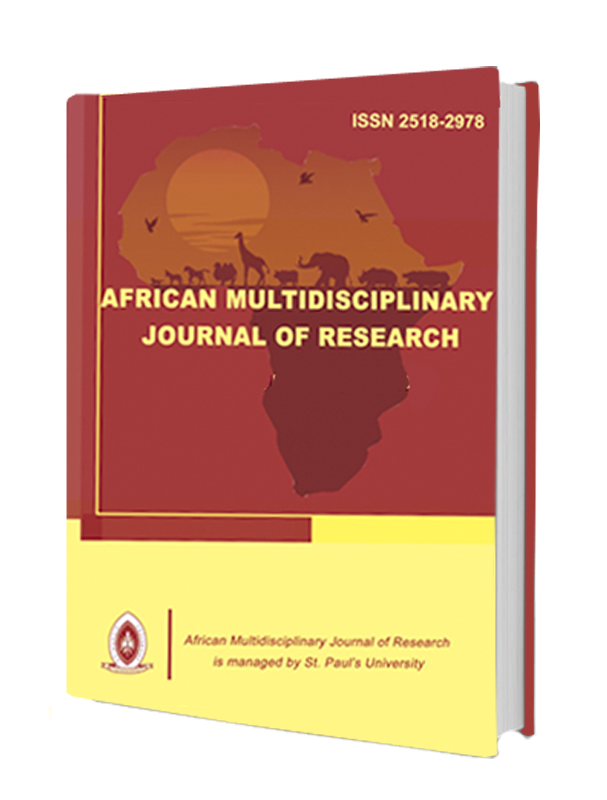The Influence of Twitter and Facebook on Public Relations Strategy in Universities: A Case Study of St Paul’s University
##plugins.themes.academic_pro.article.main##
Abstract
The main aim of this study was to determine how the use of Twitter and Facebook has influenced
how universities develop and carry out their Public Relations strategy. A case study was
conducted at St Paul’s University in order to acquire the necessary data from sources that had
insight into how the university carried out it social media strategy. Public Relations activities
such as image and brand positioning, customer relations, employee relations, marketing and
advertising on Facebook and Twitter were analyzed in order to ascertain the Public Relations
strategy of the university. The Technology Acceptance Model and the Adaptive Structuration
Theory, formed the theoretical framework of the study. The study adopted mixed research
methods during data extraction in order to acquire information from respondents. A total of 361
respondents from the Department of Communication Studies and the Public Relations
Department were targeted with an 80% response rate. The data was acquired from the Public
Relations Department using interviews while questionnaires were used to extract data from
students and lecturers in the Department of Communication Studies. After data collection,
interview data was analyzed thematically while questionnaire data was analyzed using SPSS.
The study findings revealed that the use of Facebook and Twitter had influenced how the
university developed and carried out its Public Relations Strategy. Service delivery by the Public
Relations Department had been forced to change in order to keep up with the demands of their
publics on social media. It was further revealed that there were both positives and negatives
involved in the use of these new media. Based on the findings, the study therefore recommends
that Public Relations practitioners and institutions of higher learning would be served best by
adopting social media at the corporate level.
##plugins.themes.academic_pro.article.details##
References
- Achor, P. Nwachukwu, C. & Nkwocha, C. A. (2015). An evaluation of impact of social media on information management in public relations practice. International Journal of Science and Research, 4 (10), 1697-1706.
- Adoyo, G. O. (2014). Effects of social media on Public relations in state agencies: A Case study of Kenya Revenue Authorities (KRA). Unpublished Project, JKUAT.
- Austin, L., Liu, B. F., & Jin, Y. (2012). How Audiences Seek Out Crisis Information: Exploring the Social-Mediated Crisis Communication Model. Taylor and Francis Group, 40, 188– 207.
- Awata, K. (2010). An Exploration of the Impact of Social Media on Branding Strategies.
- Cao, Xiongfei & Guo, Xitong & Vogel, Doug & Zhang, xi. (2016). Exploring the influence of social media on employee work performance. Internet Research. 26. 529-545. http://dx.doi.org/10.1108/IntR-11-2014-0299
- Chi, E. H. (2012). Who knows? Searching for expertise on the social web: Technical perspective. Communications of the ACM, 55(4), 110-110.
- Edelman, D. (2012). Social Media in the C-suites. Forbes.com. Retrieved from htt://www.forbes.com/sites/mckinsey/2012/03/22/social-meda-in-the-c-suite/
- Egwu, I. A. (2017).Influence of Social Media on Public Relations Practices in Universities in South-East, Nigeria. Global Journal of Human Social Science Research.
- Etikan, I., Musa, S. A., & Alkassim, R. S. (2016). Comparison of convenience sampling and purposive sampling. American journal of theoretical and applied statistics, 5(1), 1-4.
- Evans, A., Twomey, J., & Talan, S. (2011). Twitter as a public relations tool. Public Relations Journal, 5(1), 1-20.
- Fischer, E., & Reuber, A. R. (2011). Social interaction via new social media: How can interactions on Twitter affect effectual thinking and behavior? Journal of Business Venturing, 26(1), 1-18.
- Gordon, J. (2010). Use, value and impact of social media on public relations practitioners in the Fox Cities. Prsanewis. Org/downloads/social media_ thesis. Pdf.
- Kaplan, A. M., & Haenlein, M. (2010). Users of the world, unite! The challenges and opportunities of Social Media. Business Horizons, 53(1), 59–68. Doi: 10.1016/j.bushor.2009.09.003.
- Liu, B. F., Fraustino, J. D., & Jin, Y. (2016). Social Media Use During Disasters, How Information Form and Source Influence Intended Behavioral Responses. Sage Publications, 43(5), 626–646. https://doi.org/10.1177/0093650214565917
- Mugenda, O. M., & Mugenda, A. (2003). G. (1999). Research Methods in Education.
- New Media Consortium. (2016). A Global Imperative: The Report of the 21st Century Literacy Summit.
- Nyangau, J. Z., & N. Bado. 2012. Social Media and Marketing of Higher Education: A Review of the Literature. Journal of the Research Center for Educational Technology 8 (1): 38– 51.
- Raj, M. P., Joseph, K. J., Rousseau, J. M. (2015). Corporate Communication & Social Media: A study of its usage pattern. International Journal of Humanities and Social Science Invention, 4(8),59-66.
- Smith, B. G., & Taylor, M. (2017): Empowering Engagement: Understanding Social Media User Sense of Influence, International Journal of Strategic Communication, DOI: 10.1080/1553118X.2017.1284072
- Snoeijers, E. M., Poels, K., & Nicolay, C. (2014). University crisis: The impact of social media type, source, and information on student responses toward a university crisis. Social Science Computer Review, 32(5), 647-661.
- Stageman, A., & Berg, K. (2013). Friends, fans, and followers: a case study of Marquette University’s use of social media to engage with key stakeholders. Case Studies in Strategic Communication, 2(1).
- The Conclave. (June 2013). Complete social media measurement standards June 2013. Retrieved from: http://www.smmstandards.com/wp-content/uploads/2013/06/ Complete- standardsdocument4.pdf
- Tuten, T. L., & Solomon, M. R. (2014). Social Media Marketing. London: Sage.
- Ulbrich, F., Jahnke, I. &, Mårtensson, P (2011). Special Issue on knowledge development and the net generation. International Journal of Sociotechnology and Knowledge Development.

